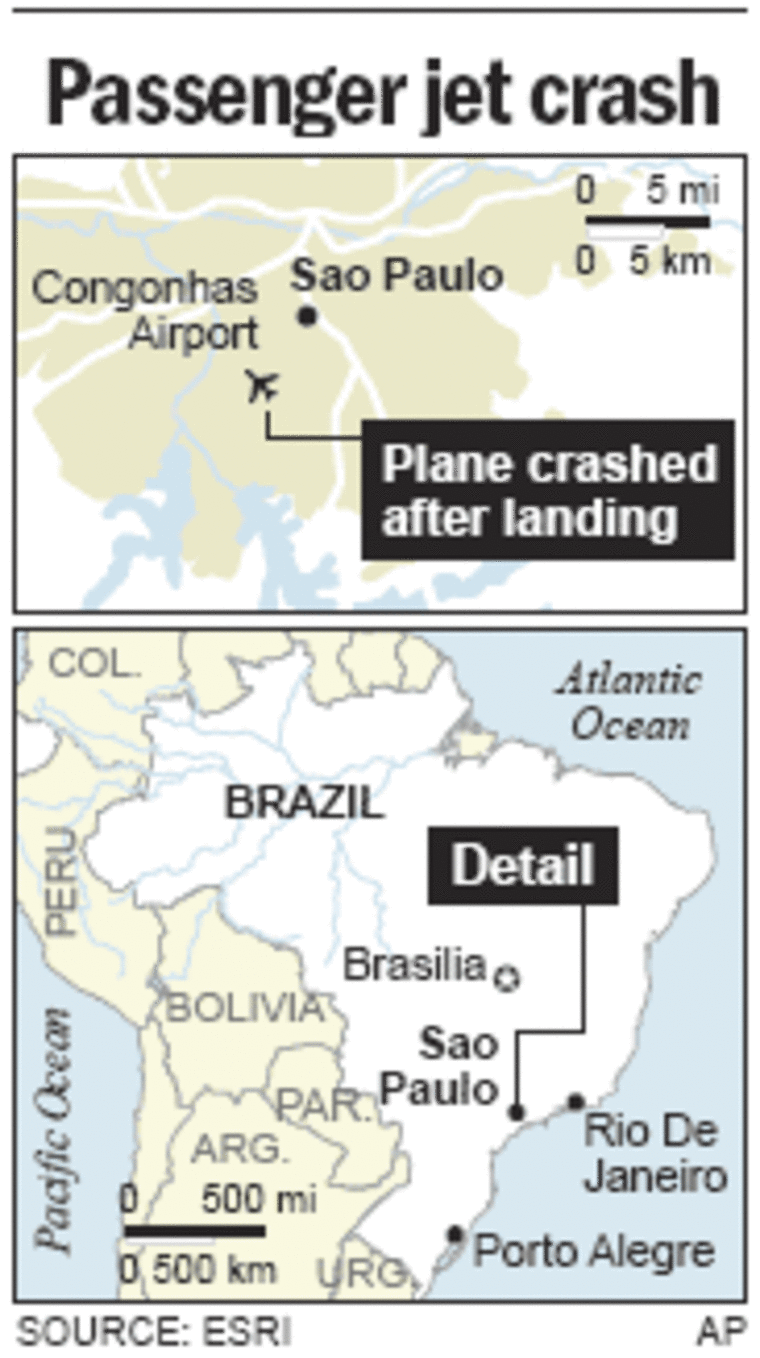Brazil’s president announced measures to make air travel safer in the country and said a new airport will be constructed in Sao Paulo, where a plane crash this week killed 191 people.
President Luiz Inacio Lula da Silva also promised on Friday that there will be a thorough investigation into the crash at a congested airport located in the midst of South America’s biggest city.
A disconnected thrust reverser emerged as a possible factor in the TAM Airlines jetliner overshooting the runway on Tuesday in Brazil’s worst air disaster. But the political heat intensified after an official expressed relief that blame for the deadly crash might shift away from the government.
‘All measures within our reach’
Silva said in a nationally televised speech that his government would take “all measures within our reach to diminish the risk of new tragedies.”
It was the first time Silva has spoken publicly on the crash, with the exception of a short statement read by a spokesman hours after the crash.
“I want everyone to know that the government is doing the possible and the impossible to investigate the causes of the accident,” Silva said. “One cannot condemn or absolve anyone on the basis of rushed opinions.”
Critics accuse officials of failing to address long-standing air travel safety problems including deficient radars, underfunded air traffic control systems and the short, slick runway at Congonhas, Brazil’s busiest airport, where the crash occurred.
All 187 people aboard the A320 and at least four on the ground died when the plane raced down the runway, skipped over a crowded highway and exploded in a fireball that was still smoldering three days later.
New safety measures
Silva defended the nation’s aviation system as secure while admitting some problems. He announced a series of measures to remedy the situation, including limiting the number of flights and restricting the weight of planes traveling into Congonhas. He also announced plans to construct a new airport in Sao Paulo, whose location would be chosen within 90 days.
“Our aviation system, in spite of the investments we have made in expansion and modernization of almost all Brazilian airports, is passing through difficulties,” Silva said. “Its biggest problem today is the excessive concentration of flights to Congonhas.”

“The security of our aviation system is compatible with all the international standards. We cannot lose sight of this,” he said.
Earlier in the day, the Cabinet-level Civil Aviation Council announced 10 measures to reduce traffic at Congonhas. The measures include banning charter flights and executive jets from the airport, and airlines were given 60 days to stop using it as a hub for connecting flights.
On Friday night, the airline added one more name to the list of people aboard its doomed plane, saying it had learned co-pilot Maros Stepansky was on the flight as a “non-working” member of the crew.
The heat on the government increased when a TV network showed one of Silva’s aides, Marco Aurelio Garcia, making an obscene gesture that was widely interpreted as a reaction of glee as he watched a report that one of the jet’s two thrust reversers had been deactivated four days before the crash.
The reversers throw the force of jet engines forward to help planes slow while landing. While it’s not unusual for twin-engine planes to use only one reverser when the other is disabled, Brazilian aviation consultant Elias Gedeon said “it is possible that the thrust reverser could have played a role” in the crash.
Too soon to determine the cause
Brazilian, French and U.S. investigators say it is too early to say what caused the crash. Recorded cockpit conversations are being analyzed in the United States and first results are not expected until next week.
Nevertheless, Garcia quickly issued a statement that he was “offended” when he learned of the mechanical problem, not only because so many people died but because “important sectors of the media didn’t hesitate to blame the government for the tragedy in Sao Paulo only a few hours after the accident.”
Brazilian media and opposition politicians insisted Friday that Garcia’s gesture, broadcast repeatedly on Brazilian television, showed the aide was pleased that political heat might be deflected away from Silva’s government.
“This attitude is unacceptable and offends all Brazilians while they are still distraught over the nation’s worst aviation tragedy,” said Tarso Jeiressati, president of the Social Democratic Party.
Shares of TAM fell 2.4 percent on Sao Paulo’s Bovespa exchange Friday.
Hours after Globo TV revealed the thrust reverser problem, TAM confirmed it had been properly deactivated and that government procedures allow jets in such condition to fly if they are inspected within 10 days.
Airport video showed TAM Flight 3054 speeding down the tarmac during a landing attempt more than four times as fast as other planes around the same time, raising the possibility of pilot or mechanical error.
Brazilian officials have said the pilot accelerated instead of slowing down after touching down, possibly indicating he was trying to get airborne again after realizing he would not be able to stop.
The Congonhas airport recently resurfaced its runway to provide better braking in rainy conditions. But the new surface had not dried enough for deep grooves to be cut in the tarmac to increase the traction of plane wheels.
Until Tuesday, Brazil’s deadliest air disaster was the 154 people killed last September when a Gol Airlines Boeing 737 collided with a small jet over the Amazon rain forest.